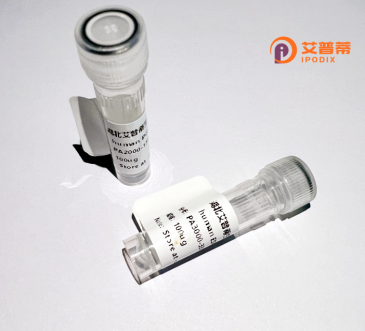
| 纯度 | >90%SDS-PAGE. |
| 种属 | Human |
| 靶点 | COG4 |
| Uniprot No | Q9H9E3 |
| 内毒素 | < 0.01EU/μg |
| 表达宿主 | E.coli |
| 表达区间 | 1-785aa |
| 氨基酸序列 | MADLDSPPKLSGVQQPSEGVGGGRCSEISAELIRSLTELQELEAVYERLCGEEKVVERELDALLEQQNTIESKMVTLHRMGPNLQLIEGDAKQLAGMITFTCNLAENVSSKVRQLDLAKNRLYQAIQRADDILDLKFCMDGVQTALRSEDYEQAAAHIHRYLCLDKSVIELSRQGKGGSMIDANLKLLQEAEQRLKAIVAEKFAIATKEGDLPQVERFFKIFPLLGLHEEGLRRFSEYLCKQVASKAEENLLMVLGTDMSDRRAAVIFADTLTLLFEGIARIVEAHQPIVETYYGPGRLYTLIKYLQVECDRQVEKVVDKFIKQRDYHQQFRHVQNNLMRNSTTEKIEPRELDPILTEVTLMNARSELYLRFLKKRISSDFEVGDSMASEEVKQEHQKCLDKLLNNCLLSCTMQELIGLYVTMEEYFMRETVNKAVALDTYEKGQLTSSMVDDVFYIVKKCIGRALSSSSIDCLCAMINLATTELESDFRDVLCNKLRMGFPATTFQDIQRGVTSAVNIMHSSLQQGKFDTKGIESTDEAKMSFLVTLNNVEVCSENISTLKKTLESDCTKLFSQGIGGEQAQAKFDGCLSDLAAVSNKFRDLLQEGLTELNSTAIKPQVQPWINSFFSVSHNIEEEEFNDYEANDPWVQQFILNLEQQMAEFKASLSPVIYDSLTGLMTSLVAVELEKVVLKSTFNRLGGLQFDKELRSLIAYLTTVTTWTIRDKFARLSQMATILNLERVTEILDYWGPNSGPLTWRLTPAEVRQVLALRIDFRSEDIKRLRL |
| 分子量 | 115.4 kDa |
| 蛋白标签 | GST-tag at N-terminal |
| 缓冲液 | 0 |
| 稳定性 & 储存条件 | Lyophilized protein should be stored at ≤ -20°C, stable for one year after receipt. Reconstituted protein solution can be stored at 2-8°C for 2-7 days. Aliquots of reconstituted samples are stable at ≤ -20°C for 3 months. |
| 复溶 | Always centrifuge tubes before opening.Do not mix by vortex or pipetting. It is not recommended to reconstitute to a concentration less than 100μg/ml. Dissolve the lyophilized protein in distilled water. Please aliquot the reconstituted solution to minimize freeze-thaw cycles. |
以下是关于重组人COG4蛋白的3篇代表性文献,涵盖功能、相互作用及结构研究领域:
---
1. **文献名称**:*"The Conserved Oligomeric Golgi (COG) complex interacts with the Golgi SNARE machinery and maintains intra-Golgi homeostasis"*
**作者**:Miller VJ, Ungar D
**摘要**:该研究探讨了COG复合体(包括COG4亚基)与高尔基体SNARE蛋白的相互作用,发现重组人COG4蛋白在调控囊泡运输和维持高尔基体结构完整性中起关键作用,缺失COG4会导致运输通路异常。
2. **文献名称**:*"Structural basis for the interaction of the human COG complex with the STX6 SNARE protein"*
**作者**:Laufman O, Hong W, Lev S
**摘要**:通过冷冻电镜和生化实验解析了人源COG4蛋白与其结合伴侣STX6的结构,揭示了COG4通过特异性结构域介导COG复合体与SNARE蛋白的结合,从而调控囊泡锚定过程。
3. **文献名称**:*"Functional characterization of COG4 mutations linked to congenital disorders of glycosylation"*
**作者**:Reynders E, Foulquier F, Leão Teles E, et al.
**摘要**:研究分析了与先天性糖基化异常(CDG)相关的COG4突变对重组蛋白功能的影响,发现突变会破坏COG复合体稳定性,导致高尔基体糖基化酶运输缺陷,为疾病机制提供分子依据。
---
如需更具体文献年份或期刊信息,可进一步缩小研究主题或补充关键词(如“晶体结构”或“疾病模型”等)。
The conserved oligomeric Golgi (COG) complex is a critical component of intracellular membrane trafficking, primarily involved in maintaining Golgi apparatus structure and function by regulating vesicle tethering and fusion. Human COG4. a subunit of the COG complex, is part of the 8-protein complex (divided into lobe A: COG1-4 and lobe B: COG5-8) that ensures proper glycosylation and sorting of cargo proteins. COG4 specifically interacts with Rab GTPases and SNARE proteins, facilitating retrograde transport within the Golgi. Dysfunction of COG4 is linked to congenital disorders of glycosylation (CDGs), particularly COG4-CDG, characterized by neurological deficits, developmental delays, and abnormal protein/lipid glycosylation.
Recombinant human COG4 protein, produced via expression systems like E. coli or mammalian cells, serves as a tool to study its structural and functional roles. Its recombinant form enables in vitro analyses, such as binding assays, structural studies (e.g., cryo-EM), or reconstitution of COG complex activity. Research on recombinant COG4 also aids in elucidating molecular mechanisms underlying Golgi-related pathologies and testing therapeutic strategies targeting glycosylation defects. Notably, mutations in COG4 (e.g., p.Cys806Tyr) disrupt complex assembly, highlighting its essentiality in Golgi homeostasis.
×